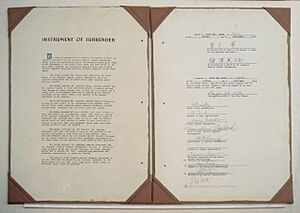Lawrence Moore Cosgrave facts for kids
Quick facts for kids
Lawrence Moore Cosgrave
|
|
|---|---|

Cosgrave signing the Japanese Instrument of Surrender aboard the battleship USS Missouri in Tokyo Bay on September 2, 1945.
|
|
| Born | August 28, 1890 Toronto, Ontario, Canada |
| Died | July 28, 1971 (aged 80) Knowlton, Quebec, Canada |
| Allegiance | Canada |
| Service/ |
Canadian Army |
| Years of service | 1912–1946 |
| Rank | Colonel |
| Awards | Distinguished Service Order & Bar Croix de Guerre (France) |
| Other work | Diplomat |
Lawrence Vincent Moore Cosgrave was a brave Canadian soldier and a clever diplomat. He was born on August 28, 1890, and passed away on July 28, 1971. He is best known for being the Canadian who signed the official surrender document for Japan at the end of World War II. This important event marked the end of the war.
Contents
Early Life and Education
Lawrence Cosgrave was born in Toronto, Ontario, Canada. His father, Lawrence J., started a company called Cosgrave & Sons Brewery. Lawrence also had a brother named James.
Lawrence Cosgrave studied at the Royal Military College of Canada. He graduated in 1912. After that, he continued his education at McGill University.
Serving in World War I
During World War I, Lawrence Cosgrave was an artillery officer. He fought with the Canadian Field Artillery in France. He was very brave and was honored twice with the Distinguished Service Order. He received this award in 1916 and again in 1918. These awards were for his "conspicuous gallantry in action," which means he showed great courage during battles.
Cosgrave fought in the Second Battle of Ypres. During this battle, he was injured and lost sight in one eye. Later, he also received the French Croix de Guerre. This is another important military award.
The Story Behind "In Flanders Fields"
Lawrence Cosgrave had a friend named Lieutenant Colonel John McCrae. Cosgrave shared a special story about how McCrae wrote the famous poem "In Flanders Fields". He said McCrae wrote the poem in just 20 minutes. This happened on May 3, 1915, during a quiet moment in the bombings. McCrae had just seen his friend, Lieutenant Alexis Helmer, die.
The poem was first published in a magazine called Punch in London. Many years later, in 1963, Cosgrave helped unveil a memorial for Colonel John McCrae in Belgium.
Writing About War Experiences
After World War I, Lawrence Cosgrave wrote a book. It was called Afterthoughts of Armageddon. The book was about his experiences during the war. He wrote about the difficult times, including poison gas and trench warfare. He dedicated the book to the "million dead" soldiers. His wife, Beryl, helped publish the book.
Serving Canada Between and During Wars
After World War I, Cosgrave worked for the Trade and Commerce Department. He helped Canada with trade around the world. He worked in London from 1922 to 1924. He also worked at the British Empire Exhibition in Wembley Park in 1924. Later, he served in Shanghai from 1925 to 1935. He then worked in Australia, in Melbourne and Sydney, until 1942.
During World War II, Cosgrave became the Canadian Military Attache to Australia. This meant he was a military expert working for Canada in Australia. On September 2, 1945, he played a very important role. He was the Canadian representative at the official surrender of Japan. He signed the Japanese Instrument of Surrender for Canada. This happened on the battleship USS Missouri in Tokyo Bay.
A Small Mistake During the Surrender
When it was his turn to sign the surrender document, Cosgrave accidentally signed on the wrong line. He signed on the line meant for the French Republic. This happened because he was blind in one eye from his World War I injury.
However, the problem was quickly fixed. US General Richard Sutherland simply crossed out "French Republic" and wrote "Dominion of Canada" under Cosgrave's signature. The Japanese delegates accepted the corrected document. Cosgrave did not make the same mistake on the Allied copy of the document.
Cosgrave actually knew the Japanese Foreign Minister, Mamoru Shigemitsu. Shigemitsu signed the surrender for Japan. They had met before when they were both diplomats in Shanghai. It is said that they recognized each other and even smiled briefly on the Missouri. They met again years later in London in 1953.
Life After the War
Lawrence Cosgrave retired from the military in 1946. He then went back to working for the Commerce Department. He held various diplomatic jobs in Asia. In the 1950s, he continued his diplomatic career in Europe. For example, he worked in Portugal from 1952 to 1955.
Cosgrave passed away on July 28, 1971, at his home in Knowlton, Quebec. Years after his death, members of the Canadian Military remembered his important career. In 2020, they posted online about his achievements. They highlighted his two Distinguished Service Orders and his Croix de Guerre.
Images for kids




